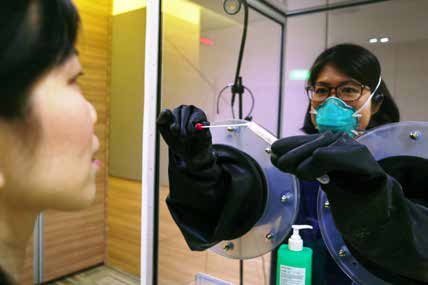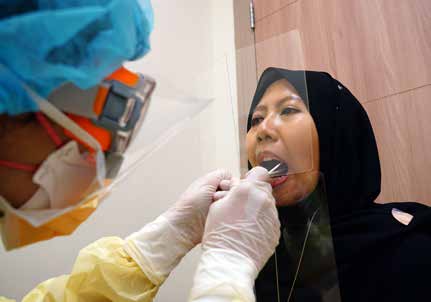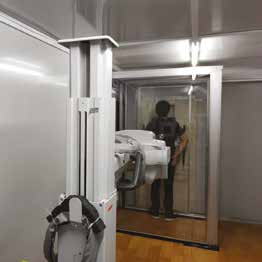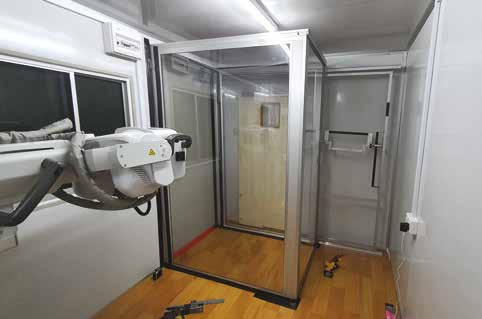SGH staff design practical alternatives to protect healthcare workers testing for the virus in the field.

>> With SG SAFE, the healthcare worker stands in the foldable booth and puts her hands into the gloves to perform a swab. She cleans and disinfects the gloves with alcohol disinfectant before each test.
To take a swab or x-ray for COVID-19 testing, doctors put on personal protective equipment (PPE) that includes a disposable gown, N95 mask, goggles, and gloves. After each procedure, he takes off his PPE, performs strict cleaning and disinfection procedures, and puts on new PPE for the next procedure.
As PPEs are cumbersome to use and uncomfortable to wear, some Singapore General Hospital (SGH) staff thought up some alternatives to protect their colleagues out in the field. Teams of SGH staff, both clinical and non-clinical, have been helping in the national effort to test thousands of migrant workers in their dormitories and community since March.
Development of prototypes took shape quickly. Safety was paramount, and the device they build had to be transportable, easy to set up, and cost-effective.
In March, as the number of COVID-19 infections started to rise alarmingly, testing was ramped up. According to the Ministry of Health on 27 April 2020, more than 8,000 tests were done a day in late April, up from an average of 2,900 in early April. Greater testing helps Singapore pick up far more cases than many other countries.
“As the demand for swab tests increased, we saw the need for a faster and more efficient way of testing without compromising the safety of healthcare workers. SG SAFE allows for efficient swabbing,” said Dr Hairil Rizal Abdullah, Senior Consultant, Department of Anaesthesiology, SGH.
SG SAFE (Swab Assurance For Everyone) is a collapsible U-shaped screen with a roof that acts as a shield between the healthcare staff and patient during testing. The doctor stands behind the clear, highp-erformance polycarbonate plastic panels, and puts his hands inside the attached gloves to perform swabbing. The gloves, made of biosafety, chemical-resistant material to withstand repeated use, are cleaned with alcohol rub after each swab.
As the doctor only wears an N95 mask that does not have to be changed, testing takes around 2.5 minutes, compared to about 5 minutes with a PPE.
A team of anaesthetists, led by Dr Hairil and biomedical incubator The BioFactory, was behind the design and manufacture of the booths, which are used at SGH’s Department of Emergency Medicine, as well as the dormitories.

>> SG SHIELD is a handheld screen with slots for a tongue depressor and swab stick, which protects the user from respiratory droplets.
Where the booth cannot be used or is unavailable, such as at the patient’s bedside, SG SHIELD can be used instead. A handheld, single-use sheet of polycarbonate plastic with slots for a tongue depressor and swab stick, it can block close to 95 per cent of respiratory droplets from the patient, said Dr Siti Radhziah Sudirman, Consultant, Department of Otorhinolaryngology – Head & Neck Surgery. Dr Siti led a team from her department, the Department of Urology, and SingHealth’s Medical Technology Office, in designing SG SHIELD.


>>In the SG SAFE.R booth, the patient undergoes x-ray scanning without coming into contact with the radiographer.
X-ray imaging of patients in the field is done inside a shipping container. Similar to SG SAFE, the SG SAFE.R is a booth with sides made of the same clear polycarbonate plastic and placed in front of the x-ray machine. The patient enters the container directly into the booth, and stands with his chest against the side facing the x-ray lead shield and detector. He is scanned without coming into contact with the radiographer, who is outside the plastic box.
Dr Lim Kheng Choon, Consultant, Department of Diagnostic Radiology, said the idea came from instant photo booths. While considering materials for the booth that had to be clear enough to not affect the quality of the scans, the news about SG SAFE broke, said Dr Lim. “We contacted Dr Hairil from the SG SAFE team to collaborate,” he added.
With the booth, only one radiographer is needed versus two before, and safety is improved, too. Any hospital staff — not necessarily a radiographer — can clean and disinfect the booth after use. Compared to the x-ray machine, the flat panels are easier and faster to clean.
The team from SGH’s Division of Radiological Sciences received approval from the National Environment Agency around early May for the booth to be used in mobile x-ray units. “The chest radiographs were clear with no problems,” Dr Lim said.
